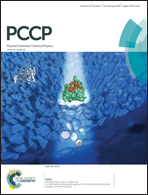The relationship between enhanced enzyme activity and structural dynamics in ionic liquids: a combined computational and experimental study†
Abstract
Candida antarctica lipase B (CALB) is an efficient biocatalyst for hydrolysis, esterification, and polymerization reactions. In order to understand how to control enzyme activity and stability we performed a combined experimental and molecular dynamics simulation study of CALB in organic solvents and ionic liquids (ILs). Our results demonstrate that the conformational changes of the active site cavity are directly related to enzyme activity and decrease in the following order: [Bmim][TfO] > tert-butanol > [Bmim][Cl]. The entrance to the cavity is modulated by two isoleucines, ILE-189 and ILE-285, one of which is located on the α-10 helix. The α-10 helix can substantially change its conformation due to specific interactions with solvent molecules. This change is acutely evident in [Bmim][Cl] where interactions of LYS-290 with chlorine anions caused a conformational switch between α-helix and turn. Disruption of the α-10 helix structure results in a narrow cavity entrance and, thus, reduced the activity of CALB in [Bmim][Cl]. Finally, our results show that the electrostatic energy between solvents in this study and CALB is correlated with the structural changes leading to differences in enzyme activity.


 Please wait while we load your content...
Please wait while we load your content...